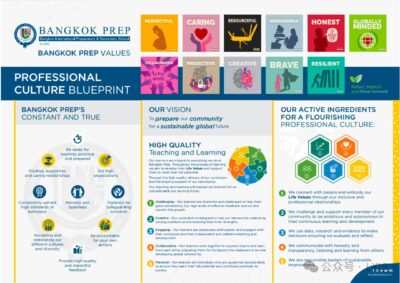by Stephen Hurworth
The grandfather of leadership studies, James MacGregor Burns, referred to leadership as ‘the most observed and least understood phenomena on earth’. One could argue that school culture could be placed firmly in the same category. Research has proven that culture can have the greatest impact on the success of the organisation but clearly defining a school culture can often be a complex process. Creating a successful, thriving and ultimately impactful school culture can be convoluted, and incredibly exhausting at times but 100% worth it if done correctly and effectively.
Community Culture vs Professional Culture…
I haven’t yet come across an International School that doesn’t promote its school values as a selling point for who they are and what they stand for. It makes complete sense to build the community culture around these values. Those values are what the school believes in to best serve their community. What about the professional culture of the organisation? Do we need to look a bit deeper at what values shape our professional behaviours, actions and beliefs? Do these not need to be defined so that when nobody is watching, everyone is aligned in doing things for the right reasons? How does that professional culture feed into achieving the School’s vision?
Defining Professional Culture…
Last academic year at Bangkok Prep we embarked on a mission to define and bolster our professional culture. It started with the Senior Leadership Team in Secondary School by conducting our own professional culture audit. It opened doors to some hearty and healthy discussions and challenges and provided a foundation to work from when exploring our professional culture with our middle leadership team. After all, according to Michael Lannini, ‘middle leaders are the true change agents in schools, they are the engines that drive transformational collaboration’.
Over a six-month period of exploration, staff voice and alignment, we eventually defined our professional culture blueprint. It is based on a set of five professional cultural values that act as our central mechanism when conversations need to be had and decisions need to be made. They form the basis of the way we do things at Bangkok Prep. We have called these our active ingredients.
Alongside our active ingredients, we utilised our school motto; ‘Constant and True’ to define a diamond 9 of non-negotiable behaviours and actions you would see in any classroom around the school. These are our ‘Constant and True’. Every staff member had an opportunity to rank 27 statements that were derived from the middle leadership team’s exploration. The top nine made the ‘grade’.
Embedding the Blueprint Within the Student Body…
Our next task was to ensure our students understood our ‘why’ behind creating and living out the blueprint. Alongside it being a beautiful visual in every classroom and working space, our middle leadership team got to work again and created and delivered a student induction programme that was centred around the blueprint. It kicked off the academic year with a two-day timetable experience with workshops, activities and discussion sessions. Our vision was to start the year off on the right foot, reinforcing who we are and what we stand for as a school community. They say professional culture is a result of historical events and we wanted our induction programme to be one of those events.
Reflect, Refresh and Move Forward… AKA the Reality!
Just last week, we got together as a Senior and Middle Leadership team to review where we are with our progress and asked ourselves three very simple questions. What should we start doing, what should we keep doing and what should we stop doing? It’s clear that both our senior and middle leaders believe in the blueprint and are on board with its purpose. There is no doubting that but the quest to fully embed its components is still a while off yet. In the great words of Lekha Sharma, ‘School culture is like Geology’. It needs to be continually developed, reviewed, monitored and finely tuned over time and there are rarely any quick wins. A commitment to the long game is needed and we are ready for the lengthy journey ahead.
I would like to finish this article by answering a few more questions we have been asking each other when conducting our learning walks.
How Have We Moved Learning Forward?
We have created a culture of organic accountability that is centred around our professional culture blueprint. It has aligned our approaches and the ‘way we do things around here’ is clearer for everyone to see, breathe and live out. In fact, one major highlight of the introduction has been our middle leaders using the blueprint to hold senior leaders accountable for the decisions we make and actions we take.
What Would We Have Done Differently and Why?
We are an all-through school so conducting this process and co-constructing it with our primary colleagues would have been, in an ideal world, the best place to start. Hindsight can be a wonderful thing but the door for future collaboration has now opened wider as we are all on the same campus. Spending more time embedding it with our teaching staff and students would also have been ideal but it’s not too late and during our recent meeting we agreed on our priorities for further embedding the blueprint.
So, what’s next?
Like any successful and aspiring organisation, we will continue to review, gather feedback and implement changes for improvement in the best interests of our community members. To answer my own ‘third space’ (reflective) question I posed to the group last week – What will our staff, students and parents be saying when our professional culture blueprint is fully embedded? We want students to say they are inspired by our professionalism – the way teachers do things at Bangkok Prep. We want staff to say they are proud to work at Bangkok Prep, continue to aspire to get better each day and be responsible leaders of sustainable improvement. Finally, we want our parents to say they are our partners on our professional culture journey.

References
Burns, J. M. (2010). Leadership (Harper Perennial Political Classics). New York: Harper Perennial.
Michael Lannini (2019). Hidden in plain sight: Realising the full potential of middle leaders.
The culture heptagon: How leaders cultivate strong school cultures (Mind the Gap podcast).
Stephen Hurworth is the Deputy Head Teacher of Secondary at Bangkok Preparatory and Secondary International School, Bangkok City, Thailand
To connect with Stephen on LinkedIn, click here

Thank you, Stephen, for sharing your insightful thoughts. It’s a pleasure to learn more about your school’s powerful actions driven by the school blueprint. Your approach sets a great example for other schools as well. I couldn’t agree more with you when you mentioned, “Our next task was to ensure our students understood our ‘why’ behind creating and living out the blueprint.” Alongside its presence as a beautiful visual in every classroom and workspace, our middle leadership team took the initiative to create and deliver a student induction program centred around the blueprint. I believe that for a school, the Mission, Vision, and Values should not merely exist on paper but be deeply understood by students and staff, practised in day-to-day life, and ingrained in the school’s culture. Wishing you and your school continued success in 2024.